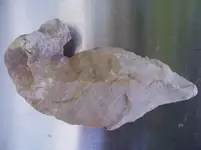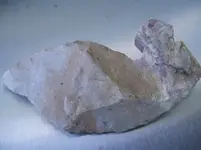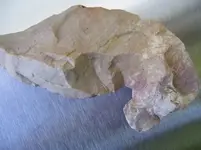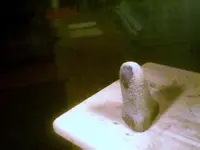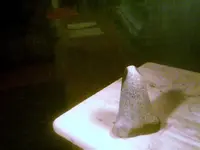You are using an out of date browser. It may not display this or other websites correctly.
You should upgrade or use an alternative browser.
You should upgrade or use an alternative browser.
Neanderthal
Bronze Member
Why, it's a seahorse effigy....of course!
It looks like a piece of angular creek cobble that got busted in a strange way. A.K.A. - geofact.
It looks like a piece of angular creek cobble that got busted in a strange way. A.K.A. - geofact.
bean man
Hero Member
Hi Jbot,
I'm not near as knowledgeable as Matt, so judge accordingly, but I think that could be something. Have any of the edges been retouched? It's hard to see workings on edges, sometimes in photos. Also, that is a flint material, isn't it?
I'm not near as knowledgeable as Matt, so judge accordingly, but I think that could be something. Have any of the edges been retouched? It's hard to see workings on edges, sometimes in photos. Also, that is a flint material, isn't it?
K
Kentucky Kache
Guest
- #4
Thread Owner
There don't seem to be much working on the edges other than what you can see in the pics. Notice the indention just below the curve. Looks like a thumb rest. It's the same material as arrowheads and it's the right size.
ohioriver hunter
Sr. Member
Agree with Matt,geofact . It would look good in an aquariam though. Ipick up lots of rocks that look like they have thumb rests. Check out the thumb rests so to speak on this one. Jeffjbot said:4" long, 2" wide.
What do you think?
Attachments
Michael Karr
Sr. Member
It's just a piece of flint!!
K
Kentucky Kache
Guest
- #7
Thread Owner
I don't think It's just a piece of flint.
Neanderthal
Bronze Member
Jbot, I'm going to assume that it wasn't you who emailed me today (anonymously, go figure) concerning this post. However, somebody did, with ill intent. They meant it to be threatening but it only came across as comical.
Ok, here's what I see in your stone. I see no compression rings, bulb of force or conchoidal imprint that signify intentional flake removal by means of pressure or percussion flaking. Knapping leaves tell-tale scars that are generally distinguishable from the haphazzard "breaks" that can occur from the forces of nature itself. I can see absolutely no signs of human modification on your piece that would classify it as an artifact. However, I may be missing something.
Here is a link to a flint reduction primer that I made some time back. It may help show you some identifiable features in determining flaked artifacts.
http://arrowheads1.com/flaking/primer.htm
Matt
Ok, here's what I see in your stone. I see no compression rings, bulb of force or conchoidal imprint that signify intentional flake removal by means of pressure or percussion flaking. Knapping leaves tell-tale scars that are generally distinguishable from the haphazzard "breaks" that can occur from the forces of nature itself. I can see absolutely no signs of human modification on your piece that would classify it as an artifact. However, I may be missing something.
Here is a link to a flint reduction primer that I made some time back. It may help show you some identifiable features in determining flaked artifacts.
http://arrowheads1.com/flaking/primer.htm
Matt
K
Kentucky Kache
Guest
- #9
Thread Owner
I haven't emailed you.
I just don't think the shape of this piece is accidental. why would a skinner be knapped, other than in the hook?
I just don't think the shape of this piece is accidental. why would a skinner be knapped, other than in the hook?
Neanderthal
Bronze Member
Jbot, you're right that it wouldn't have to be knapped over it's entirety. However, I don't see knapping scars on the inside of the hook either? They look like angular breaks. I'm not saying the natives didn't use it...they very well could have. But, I don't think it was a manufactured artifact for a specific purpose. To me, the form appears to be completely incidental? I'm only stating my opinion, you did ask.
I'm glad to hear it wasn't you who sent the emails...he was completely out of this world! Black helicopter stuff and all. LOL
I'm glad to hear it wasn't you who sent the emails...he was completely out of this world! Black helicopter stuff and all. LOL
bean man
Hero Member
Sorry that happened Matt, but I wouldn't concern myself with some chicken$hit, that won't even put his name behind his threat.
Cannonman17
Bronze Member
Geofact
Similar threads
- Replies
- 4
- Views
- 311
- Replies
- 4
- Views
- 342
Users who are viewing this thread
Total: 1 (members: 0, guests: 1)



